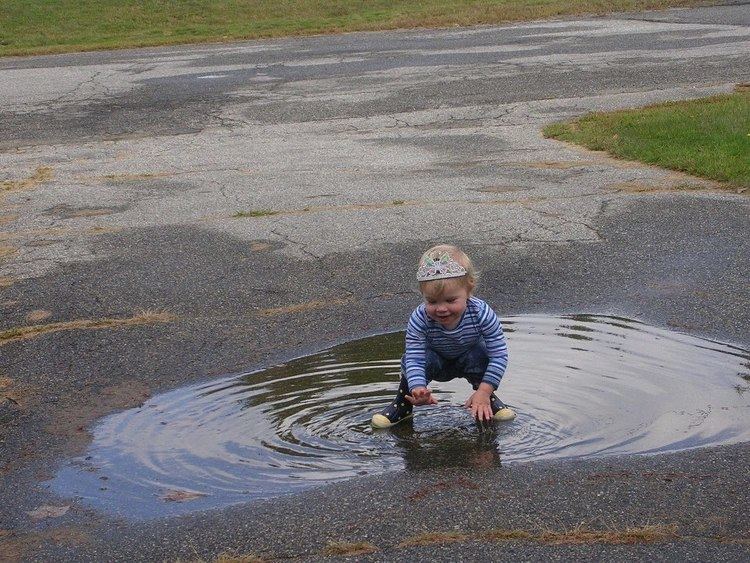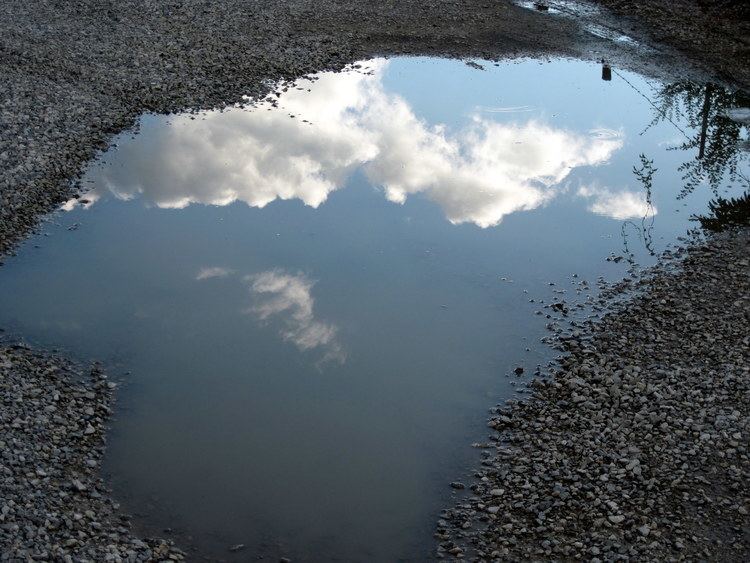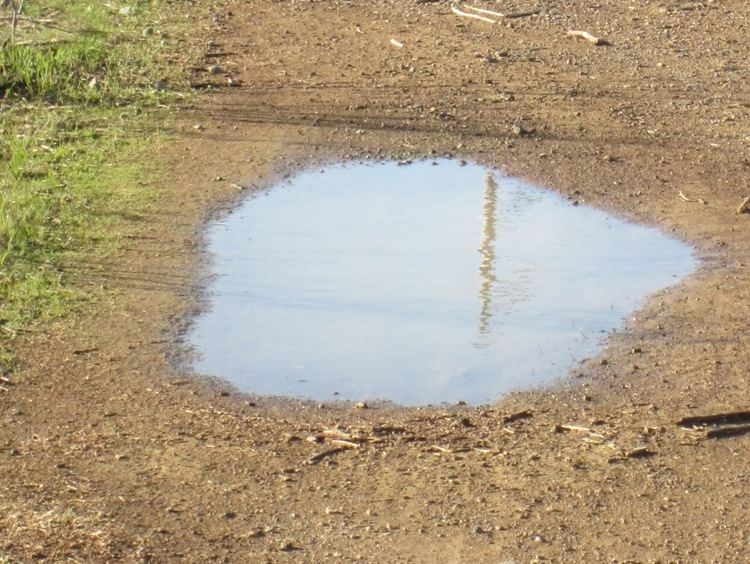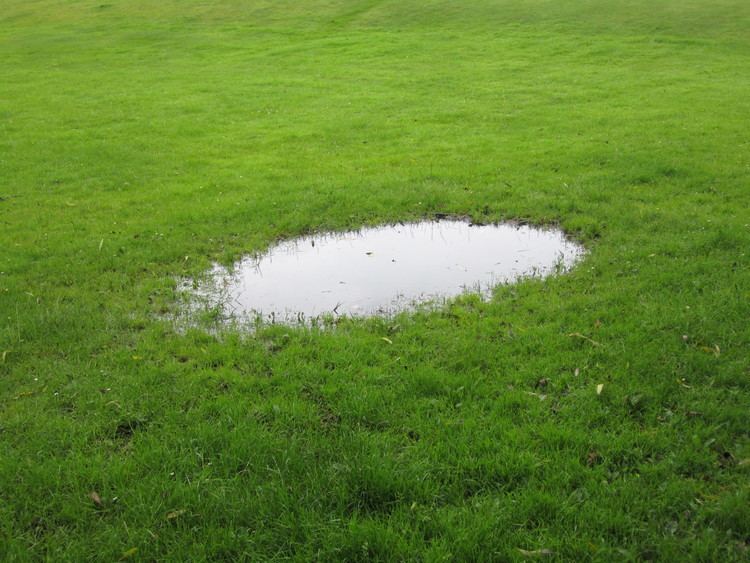 | ||
Puddle of mudd blurry official video
A puddle is a small accumulation of liquid, usually water, on a surface. It can form either by pooling in a depression on the surface, or by surface tension upon a flat surface.
Contents
- Puddle of mudd blurry official video
- Weird place puddle original song
- Natural puddles and wildlife
- Puddles on roads
- Physics
- Children
- Puddle thinking
- History
- References

A puddle is generally shallow enough to walk through, and too small to support a boat or raft. Puddles can be a source of fascination for children. Small wildlife may be attracted to puddles.

Weird place puddle original song
Natural puddles and wildlife

Puddles in natural landscapes and habitats, when not resulting from precipitation, can indicate the presence of a seep or spring. They can provide essential moisture for small wildlife, such as birds and insects. Many butterfly (Lepidoptera) species need puddles for mud-puddling to obtain nutrients such as salts and amino acids.
Swallows use the damp loam which gathers in puddles as a form of cement to help to build their nests. The reduction in the number of puddles in the countryside due to intensive farming, urban sprawl, and climate change is partially the cause of a decrease in the swallow population. Small seasonal riparian plants, grasses, and wildflowers germinate with the ephemeral "head start" of moisture.

Wildlife can use puddles as a drinking source, for bathing (e.g. birds), or in the case of some smaller forms such as tadpoles or mosquito larvae, an entire habitat. Raised constructed puddles, bird baths, are a part of domestic and wildlife gardens as a garden ornament and "micro-habitat" restoration. In a behaviour known as puddling, butterflies and some other insects, but particularly male butterflies, are known to seek out the damp mud they can find around the edge of puddles.
Puddles that do not evaporate quickly can become standing water, which can become polluted by decaying organisms and are often home to breeding mosquitos, which can act as vectors for diseases such as malaria and, of more recent concern in certain areas of the world, West Nile Virus.
Puddles on roads
Puddles commonly form during rain, and can cause problems for transport. Due to the angle of the road, puddles tend to be forced by gravity to gather on the edges of the road. This can cause splashing as cars drive through the puddles, which causes water to be sprayed onto pedestrians on the pavement. Irresponsible drivers may do this deliberately, which, in some countries, can lead to prosecution for careless driving.
Puddles commonly form in potholes in a dirt road, or in any other space with a shallow depression and dirt. In such cases, these are sometimes referred to as mud puddles, because mud tends to form in the bottoms, resulting in dirtied wheels or boots when disturbed.
In order to deal with puddles, roads and pavements are often built with a camber (technically called 'crowning'), being slightly convex in nature, to force puddles to drain into the gutter, which has storm drain grates to allow the water to drain into the sewers. In addition, some surfaces are made to be porous, allowing the water to drain through the surface to the aquifer below.
Physics
Due to the action of surface tension, small puddles can also form if a liquid is spilt on a level surface. Puddles like this are common on kitchen floors. Puddles tend to evaporate quickly due to the high surface-area-to-volume ratio and tend to be short lived. In cold conditions puddles can form patches of ice which are slippery and difficult to see and can be a hazard to road vehicles and pedestrians.
Children
Puddles are a source of recreation for children, who often like jumping in puddles as an "up-side" to rain. A children's nursery rhyme records the story of Doctor Foster and his encounter with a puddle in Gloucester. muddy puddles, and the pleasures of splashing mud in them, are a repeated theme in the children's animation Peppa Pig, to the extent of selling character-branded wellington boots.
Puddle thinking
It has been fashionable for millennia, and continues to be fashionable in some circles, to believe the Universe is designed for humans. Some critics of this view reject it as hubris or anthropocentrism and argue instead that through the process of evolution it is humans that have adapted to or been shaped by the Universe. In his book The Salmon of Doubt, Douglas Adams satirizes the belief that the universe is designed for humans:
imagine a puddle waking up one morning and thinking, 'This is an interesting world I find myself in, an interesting hole I find myself in, fits me rather neatly, doesn't it? In fact, it fits me staggeringly well, must have been made to have me in it!' This is such a powerful idea that as the sun rises in the sky and the air heats up and as, gradually, the puddle gets smaller and smaller, it's still frantically hanging on to the notion that everything's going to be all right, because this World was meant to have him in it, was built to have him in it; so the moment he disappears catches him rather by surprise.
History
When Walter Raleigh met Queen Elizabeth I, Raleigh is reputed to have thrown his coat over a muddy puddle to allow the Queen to cross without getting her feet wet as an act of chivalry.
Medieval legend spoke of one man who was desperate to find building materials for his house, so he stole cobblestones from the road surface. The remaining hole filled with water and a horseman who later walked through the 'puddle' actually found himself drowning. A similar legend, of a young boy drowning in a puddle that formed in a Pothole in a major street in the early years of Seattle, Washington, is told as part of the Seattle Underground Tour.
